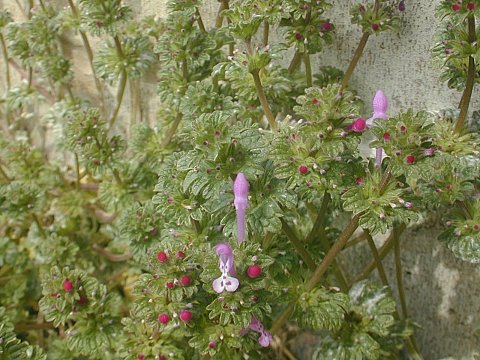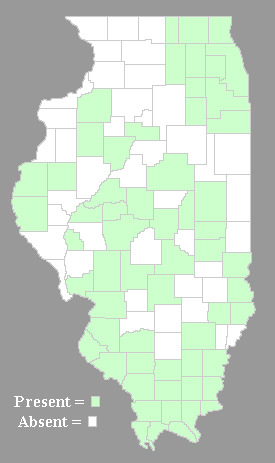Description: This plant is a winter annual, branching frequently near the base. The green or reddish brown stems are 4-angled, nearly glabrous, and up to 2' long. They have a tendency to sprawl across the ground, although the new growth of the stems is more erect. The opposite leaves are up to 1" long and across, occurring at intervals along the stems. The lower leaves have long petioles, while the upper leaves where the flowers occur are sessile and wrap around the stems. They are orbicular, crenate, and/or palmately lobed; these lobes are shallow, but cleft. The upper surface of the leaves has conspicuous palmate venation and is slightly hairy.

The stems produce
axillary and terminal whorls of 6-12 sessile flowers where the sessile
leaves occur. Each tubular flower is about ½" long and semi-erect. The
corolla of this flower is long and narrow at the base, becoming broader
with two spreading lips. The upper lip is shaped like a hood with a
patch of fine hairs on its outer side, while the lower lip hangs
downward. This lower lip is narrow at the base, but become broader and
divided into two rounded lobes along its outer edge. The outer surface
of the corolla is pink to purplish pink, while its inner surface is
white with a few purplish pink dots. The green calyx is slightly hairy
and has 5 narrow teeth; it is much shorter than the corolla. In
addition to these insect-pollinated flowers, Henbit also produces
inconspicuous cleistogamous flowers occasionally. The blooming period
occurs primarily during the spring and lasts about 1-2 months; some
plants also bloom during the fall for about a month. Each flower is
replaced by 4 nutlets. Each nutlet is 3-angled, oblong, and somewhat
broader and more rounded at one tip than the other. Its surface is
greyish brown with small white speckles. The root system consists of a
shallow taproot that becomes finely branched. This plant reproduces by
reseeding itself, or it can reproduce vegetatively by the stems rooting
at the nodes.
lasts about 1-2 months; some
plants also bloom during the fall for about a month. Each flower is
replaced by 4 nutlets. Each nutlet is 3-angled, oblong, and somewhat
broader and more rounded at one tip than the other. Its surface is
greyish brown with small white speckles. The root system consists of a
shallow taproot that becomes finely branched. This plant reproduces by
reseeding itself, or it can reproduce vegetatively by the stems rooting
at the nodes.
Cultivation:
Typical growing conditions are full or partial sun and moist to mesic
soil that is loamy and fertile. Plants become dormant during the hot
weather of summer.
Range & Habitat:
The non-native Henbit is fairly common in most areas of Illinois,
except the NW, where
it is uncommon or absent. This plant is native to Eurasia and Africa.
Habitats include fields, pastures, gardens, nursery plots, edges of
yards, lawns, waste areas, and areas along buildings. There is a strong
preference for disturbed areas. Henbit can spread aggressively.
Faunal Associations:
The nectar and pollen of the early blooming flowers attract
long-tongued bees primarily, including honeybees and bumblebees. The
foliage is eaten by voles and box turtles, while rabbits rarely bother
it.
Photographic Location:
Along the foundation of the webmaster's apartment complex in Urbana,
Illinois.
Comments:
Henbit is another common weed from Eurasia that occasionally makes a
nuisance of itself. It is easy to identify because of the sessile
orbicular leaves that appear to wrap around the sprawling stems. Other Lamium
spp. (Dead Nettles) are more erect plants; their upper leaves
don't wrap around the stems. Another plant that resembles Henbit
somewhat is Glechoma hederacea (Ground Ivy). The
leaves of Ground Ivy always have petioles, and its flowers occur in
smaller clusters from the leaf axils. These flowers are violet-blue or
purple and rather broad with conspicuous side lobes, while the more
narrow flowers of Henbit are pink and lack such side lobes. The common
name 'Henbit' refers to the seeds, which presumably can be eaten by
chickens.